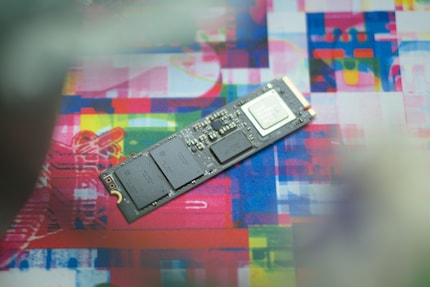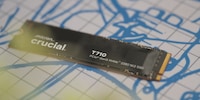

Review: meet the WD Black SN8100, the new queen of SSDs
Sandisk’s new SSD has been a long time coming, but it’s made quite the splash. The first WD Black PCIe 5.0 model impresses in terms of both performance and efficiency.
As the saying goes, good things come to those who wait. This is certainly true of WD Black’s new SSD, the catchily named SN8100. While other manufacturers began releasing their first PCIe 5.0 standard SSDs over two years ago, Sandisk has only just followed suit now. However, the wait seems to have paid off; the SSD comes out on top in almost every category.
The technical details
I tested the 2-terabyte (TB) version of the SSD. Each terabyte of memory has one gigabyte (GB) of Micron DRAM. This is used to store stuff like data allocation tables, which record logical blocks and their positions in the memory. So if you buy a different memory size, the specifications may change.
Sandisk has used its own BiCS8 TLC NAND for the flash. NAND is a non-volatile memory technology that doesn’t require power to store data. TLC stands for Triple Level Cell. This means three bits are allocated per memory cell, stacked over 218 layers.
Like the DRAM, the SSD’s controller has been bought in from elsewhere. It’s a customised SM2508 from Silicon Motion – a more economical controller than the Phison E26, which has been the go-to for consumer SSDs for a while now.

Sandisk promises 600 terabytes written (TBW) per TB of memory. That’s the number of TB that an SSD can write in its lifetime. These are conservative values, as drives usually achieve more. With my test SSD, I could write 1 TB of data per day for over three years. But that’s an unrealistic scenario. The manufacturer’s warranty lasts five years.
Reading: only small differences
I measured the SSD’s read speed using the CrystalDiskMark program. This revealed only minor differences between the PCIe 5.0 SSDs. The new WD Black is significantly faster than its predecessor, the SN850X, which still comes in the PCIe 4.0 standard. When it comes to random reading, however, the differences are less pronounced.
The first value in the graphic below refers to sequential reading, while the second refers to random reading and writing. If you work with large files, the first bar will be relevant for you. For small files, check the second.
Writing: new chart-topping values
The differences are more significant when it comes to writing. In fact, the new Sandisk is eleven per cent ahead of the Crucial SSD. When it comes to random writing, the figure is still ten per cent. In this category, the predecessor SN850X beats the new SN8100. So far, it seems like PCIe 4.0 SSDs are better at handling numerous smaller files.
As a practical test, I copy a 10-gigabyte file from a RAM disk to the SSD. The RAM disk ensures that the SSD is the bottleneck, since the disk will achieve a much higher write and read rate. The SN8100 achieves a new peak value in this category during my tests.
To test how the SSD behaves when writing data continuously, I repeatedly write the 10-gigabyte test file from the RAM disk to the SSD using a batch command. This way, I can tell when it starts to throttle down. The SN8100 hits the brakes for the first time once 100 GB of data has been written. Instead of 5,900 megabytes per second (MB/s), it only manages 4,100 MB/s. Once it’s written 800 GB of data, it throttles back to an average of 2,000 MB/s. After that, it maintains this speed until it’s full. The Sandisk throttles faster than the T705. The Crucial only slows down once 200 GB of data has been written. However, the SN8100 is always faster beyond that point.
The clear winner in the copying category
When copying, i.e. reading and writing to the SSD at the same time, I duplicate the 10 GB file. This is where the SN8100 is clearly a cut above the T705. It also beats its predecessor.
Pole position in office applications
The SN8100 comes out on top in office applications. Bear in mind that even the SN850X is lightning fast in applications like these. You’ll hardly notice these benchmark differences in real life.
Gaming: another new peak value
The SN8100 also tops the rankings in the 3DMark gaming benchmark, albeit by a narrow margin.
How the SSD behaves at 80 per cent full
I ran all tests mentioned above with an empty SSD. However, generally speaking, you’ll fill your drive over time. At 80 per cent full, the SSD doesn’t always lose performance. When reading, it reaches 14,928 MB/s, almost the same value as when empty. However, the SSD is six per cent slower when writing in practice. The greatest loss shows up when copying, at 16 per cent. I didn’t measure any performance losses in the office or gaming benchmarks.
Stays cool
The SN8100 isn’t just seriously fast – it’s cool too. Even during my continuous write test, it hit a maximum temperature of 58 degrees Celsius. When I tested the T705, it heated up to around 85 degrees Celsius. This ability to stay cool is probably partly down to the SN8100’s low power consumption of no more than seven watts. The T705, on the other hand, draws 12 watts.
In a nutshell
Fastest SSD on the market
If it’s maximum performance you’re after, you can’t overlook the WD Black SN8100. Sandisk’s new SSD comes up trumps in every test bar one.
It’s also ahead of the competition when it comes to efficiency. Drawing just seven watts under load, the SN8100 is more economical than its rivals. That’s down to the new SM2508 controller from Silicon Motion.
Alas, all this comes at a price. At around 250 Swiss francs (as of 3 June 2025), it’s currently more expensive than competing models from Crucial or Samsung. That being said, those have been on the market for a long time. The price of the SN8100 might well fall into line with the competition in the coming months. If that happens, there’ll be nothing standing in its way.
Pro
- Currently the fastest SSD on the market
- Low power consumption, resulting in low operating temperature

From big data to big brother, Cyborgs to Sci-Fi. All aspects of technology and society fascinate me.


